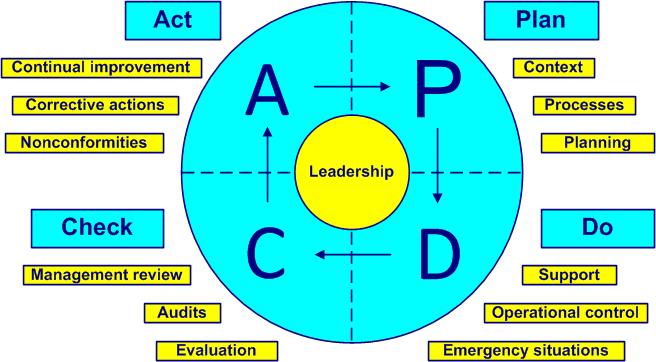1 QSE approach
1.1 History
Quality, occupational health and safety, environment, integrated management system
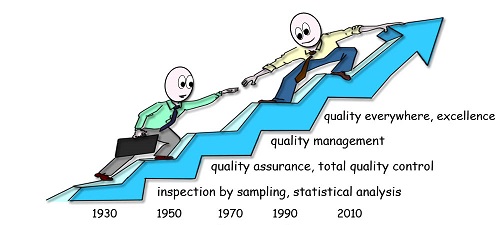
1.1.1 QSE
The QSEquality, safety, environment manager (quality, safety, environment) prepares, implements, maintains and improves the integrated management system (IMSintegrated management system). The IMSintegrated management system finds its origins in the management systems of:
- the quality
- health and safety at work
- the environment
The targets are different (the productany outcome of a process or activity (see also ISO 9000, 3.4.2), the personnel, the environment) but complementary because no company can do without one of the three elements.
Quality (Q)
In the code of King Hammurabi of Babylon (1730 BC), we find one of the oldest written traces of quality requirements:
- if an architect builds a house and one of the walls falls, this architect will consolidate this wall at his own expense
- if an architect builds a house and the house collapses and the master of the house is killed, that architect is liable to death
Quality comes from the Latin word qualitas, "way of being", itself derived from the adjective qualis, "as it is".
There are many definitions of the word quality. Some examples:
- state, disposition - Aristotle
- property, attribute - René Descartes
- compliance with requirements - Philip Crosby
- anything that can be improved - Masaaki Imai
- fitness for use - Joseph Juran
- ability to satisfy the customer - Kaoru Ishikawa
- degree to which a set of inherent characteristics of an object fulfils requirements, ISO 9000: 2015, § 3.6.2
- absence of defects, Joseph Juran
- seeking the satisfaction of all parties involved in a transaction - Yvon Mougin
- level of excellence
- take pride in your work (work well done)
- do it right the first time and all the time
- it is when the customer likes the product and the employee likes to make the product
- it's when the customer comes back and not the product
The Petit Robert alone gives us six different meanings for the word quality.
Our choice:
Quality: aptitude to fulfill requirements
Everyone makes quality, like Monsieur Jourdain made prose.
Everyone has a point of view on quality, often personal and interesting.
No one is against quality and in principle everyone accepts that:
Quality is a journey, not a destination
The latest version of the international standard ISO 9001 for an integrated management system dates from 2015.
ISOinternational organization for standardization comes from the Greek “isos” (equal). ISOinternational organization for standardization (International Organization for Standardization) was created in 1947.
Occupational health and safety (S)
The first laws relating to safety at work appeared in France at the end of the 19th century.
According to the ILO - International Labor Organization, the tripartite UN agency (representatives of governments, employers and workers) to promote decent work throughout the world, approximately 2.3 million people die each year in the world of work. There are more than 270 million work accidents each year and some 160 million cases of occupational diseases worldwide. The concept of decent work implies safe work, which leads to the economic well-being of people.
A proven way to protect workers is to implement an occupational health and safety management system.
The integration of the assessment of professional risks (related to the health and safety of workers) in the management of each company has been an obligation of the French labor code since 2001 (R4121-1). For more information see annex 01. 
One of the first widely used standards for occupational health and safety management was the standard “BS OHSAS 18001: Occupational health and safety management systems – Requirements” published in 1999 and revised in 2007 (no longer valid since March 2021). It was neither a French standard nor an ISOinternational organization for standardization standard.
Practical recommendations can be found in the ILO - OSH 2001 reference framework "Guidelines on occupational health and safety management systems", a document published in 2001 and downloadable free of charge from the website of the International Labor Organization ILO ( pdf, 300 kb, 44 pages). The correspondences between ISO 45001 and ILO 2001 are shown in annex 02. 
The first edition of the international standard ISO 45001 for occupational health and safety was published in 2018.
Environment (E)
The first laws on environmental protection appeared in the 70s of the last century in response to the scale of the harmful impacts of modern industry. The concept of environmental protection is one of the pillars of sustainable development.
Pollution prevention is an essential step for every responsible business.
The first edition of the ISO 14001 environmental management system (EMSenvironmental management system) standard appeared in 1996.
The three pillars of sustainable development remain the balance between:
- the society
- the environment and
- the economy
The ISO 14001 environmental management system as an environmental pillar of sustainable development requires to:
- be in compliance with regulations
- prevent pollution
- be able to respond to emergency situations
The latest edition of the ISO 14001 standard dates from 2015 and is distinguished by:
- the new (higher level) structure
- addition of the risk approach
- compatibility between strategic orientation and environmental policy
- top management fully assumes responsibility (leadership) for the performance of the EMS
1.1.2 Common concepts
The three management systems (see figure 1-1) quality, safety and environment have the following concepts in common:
- PDCA approach
- process approach
- context
- stakeholders:
- needs
- expectations
- requirements
- risks
- satisfaction
- management leadership
- management commitments:
- policy
- objectives
- planning
- implementation
- communication
- resources
- management review
- document control
- operational control
- evaluation of performances :
- monitoring and measurement (inspection)
- internal audits
- continual improvement
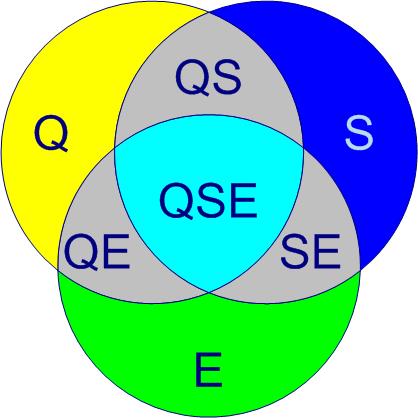
Figure 1-1. QSE common concepts
Certain common points are specific to two management systems (QS, QE and SE) and reinforce the integration of the QSEquality, safety, environment systemset of interacting processes (see also ISO 9000, 3.2.1).
1.1.3 QSE department
For centuries, quality was intrinsic to all craftsmanship (facilitated by direct contact with the customeranyone who receives a product (see also ISO 9000, 3.3.5)).
With the advent of industrialization (mass production) appeared the division of labor (design, production and inspection) and the interchangeability of parts (beginning of standardization).
In 1924, for the first time, a "quality assurance" department was created in the Bell Telephone company to better satisfy the end customeranyone who receives a product (see also ISO 9000, 3.3.5). At that time in this company, people who would become world-renowned thought leaders such as Shewhart, Deming and Juran worked on and developed the “statistical quality control” approach.
In the 1930s, excesses were reached. For example, in the same Bell Telephone company, it was noticed at one point that the inspection staff was more numerous than the workers!
Until the early 1940s, the inspection department (often called control) had the mission of verifying the conformity of finished productsany outcome of a process or activity (see also ISO 9000, 3.4.2). It was expensive (lots of checks) and not very efficient (defects were discovered at the end of the production cycle).
During the Second World War it was realized that poor quality could be very expensive – a direct link to human lives. Use of inspection at all stages of production began and certain requirementsexplicit or implicit need or expectation (see also ISO 9000, 3.1.2) became mandatory (including reception). A finished production with a lot fewer defects was obtained (they were discovered quite early).
The first American military standards for inspection by sampling were put in place.
In 1949, the American Society for Quality Control (ASQC) was created.
The 1960s and 1970s saw the appearance of quality department, continual improvementpermanent process allowing the improvement of the global performance of the organization (see also ISO 9000, 3.2.13 and ISO 14 001, 3.2), prevention, the daily use of statistics in production, the involvement of all personnel and team spirit for quality. Many approaches and various tools emerged (see Chapters 9 and 10 of this module).
The first international standards related to quality (ISO 9000 family) appeared in 1987. We talk about quality assurance, zero defects, prevention, corrective and preventive actions and supplier quality assurance (SQA).
During the 1980s, the quality system encompassed all departments, all activities and all personnel.
In the 90s of the 20th century, the functions responsible for safety and environment appeared and the first ISO 14001 and OHSAS 18001 certifications.
Slowly but surely the QSEquality, safety, environment department is transforming from a compliance expertise service into a cross-functional support service. The control of processes and the effectiveness of the management system are beginning to include new expectations related to efficiency, innovation, occupational safety and health, environmental protection, and sustainable development.
1.2 Principles
Seven management principles
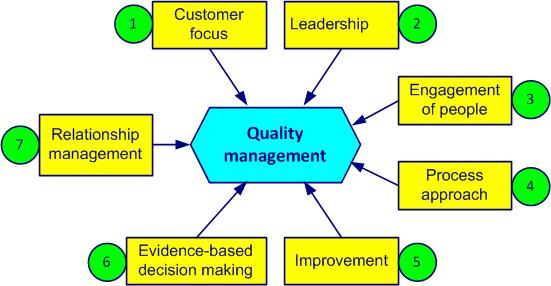
1.2.1 Management principles
The QSEquality, safety, environment approach is a state of mind that starts with top management as a priority strategic decision and extends to all staff. Top management defines the QSEquality, safety, environment policy, in which the QSEquality, safety, environment objectives are set and applicable to all activities. The tool used to achieve the objectives is the management systeme. The concept of prevention is generalized.
The purpose of a management system (MS) is to increase customer satisfactiontop priority objective of every quality management system (see also ISO 9000, 3.1.4) (external and internal) by meeting their needs and expectations by continually improving processactivities which transform inputs into outputs (see also ISO 9000, 3.4.1) efficiency.
Quality costs almost nothing when customers are satisfied: they remain loyal to us. It is only when the customeranyone who receives a product (see also ISO 9000, 3.3.5) is not completely satisfied that quality becomes very expensive for us: sooner or later the customeranyone who receives a product (see also ISO 9000, 3.3.5) goes to a competitor.
Quality remains long after the price has been forgotten
The seven principles of quality management (see figure 1-2) will help us achieve sustainable performance (see ISO 9001: 2015, § 0.2)
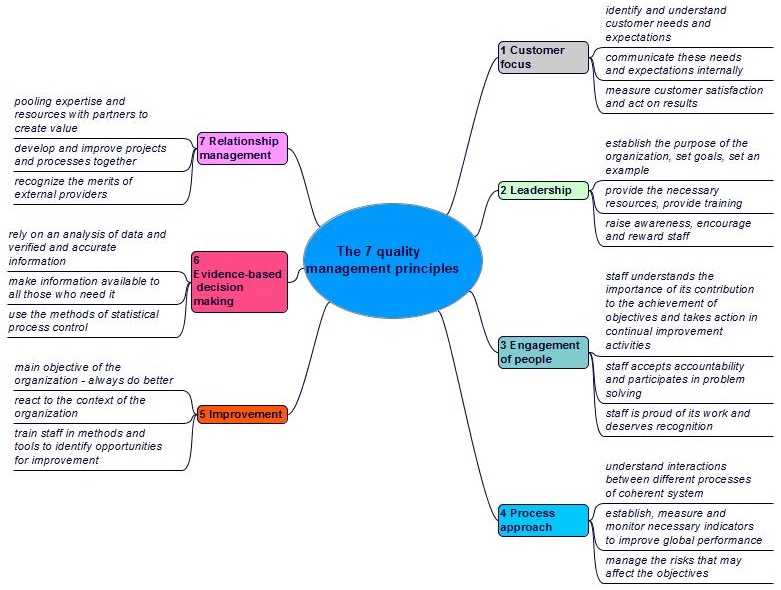
Figure 1-2. The seven principles of quality management
1.2.2 PDCA cycle
The PDCA cycle, also called Deming cycle, applies to the control of any processactivities which transform inputs into outputs (see also ISO 9000, 3.4.1). PDCA (Plan, Do, Check, Act) cycles are a universal basis for continual improvementpermanent process allowing the improvement of the global performance of the organization (see also ISO 9000, 3.2.13 and ISO 14 001, 3.2) (see figure 1-3).
- Plan – define and establish context, issues and processes, demonstrate leadership, establish QSE policy and objectives
- Do – develop, produce the product, control the processes, demonstrate leadership, provide support, respond to emergency situations
- Check – compare, verify, evaluate, inspect, analyze data, conduct audits, carry out management reviews, demonstrate leadership
- Act – adapt, demonstrate leadership, treat nonconformities, respond with corrective actions and find new improvements (new PDCA)
1.3 Process approach
Process types, management, realization, support processes, process mapping, process approach
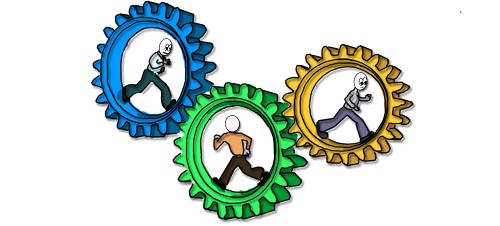
If you cannot describe what you are doing as a process, you do not know what you're doing. Edwards Deming
1.3.1 Process types
The word processactivities which transform inputs into outputs (see also ISO 9000, 3.4.1) comes from the Latin root procedere = go, development, progress (Pro = forward, cedere = go). Each processactivities which transform inputs into outputs (see also ISO 9000, 3.4.1) transforms inputs into outputs, creating added value and potential nuisances.
A processactivities which transform inputs into outputs (see also ISO 9000, 3.4.1) has three basic elements: inputs, activities and outputs. 
A processactivities which transform inputs into outputs (see also ISO 9000, 3.4.1) can be very complex (launch a rocket) or relatively simple (audit a productany outcome of a process or activity (see also ISO 9000, 3.4.2)). A processactivities which transform inputs into outputs (see also ISO 9000, 3.4.1) is:
- repeatable
- foreseeable
- measurable
- definable
- dependent on its context
- responsible for its external providers
A processactivities which transform inputs into outputs (see also ISO 9000, 3.4.1) is, among other things, determined by its:
- title and its type
- purpose (why?)
- beneficiary (for whom?)
- scope and activities
- initiators
- documents and records
- inputs
- outputs (intentional and unintentional)
- restrains
- people
- material resources
- objectives and indicators
- person in charge (owner) and actors (participants)
- means of inspection (monitoring, measurement)
- mapping
- interaction with other processes
- risks and potential deviations
- opportunities for continual improvement
A processactivities which transform inputs into outputs (see also ISO 9000, 3.4.1) review is carried out periodically by the processactivities which transform inputs into outputs (see also ISO 9000, 3.4.1) owner (cf. annex 03).
The components of a processactivities which transform inputs into outputs (see also ISO 9000, 3.4.1) are shown in figure 1-4:

Figure 1-4. Components of a process
Figure 1-5 shows an example that helps answer the questions:
- which materials, which documents, which tooling? (inputs)
- which title, which activities, requirements, constraints? (process)
- which products, which documents? (outputs)
- how, which inspections? (methods)
- what is the level of performance? (indicators)
- who, with what competence? (staff)
- with what, which machines, which equipment? (material resources)
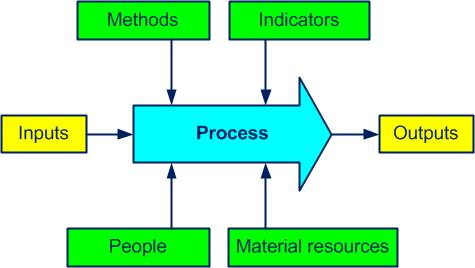
Figure 1-5. Some elements of a process
Often the output of a processactivities which transform inputs into outputs (see also ISO 9000, 3.4.1) is the input of the next processactivities which transform inputs into outputs (see also ISO 9000, 3.4.1).
You can find some examples of process forms in the document pack D 02 and annex 04.
Any organizationa structure that satisfies a need (see also ISO 9000, 3.3.1) (company) can be considered as a macro processactivities which transform inputs into outputs (see also ISO 9000, 3.4.1), with its purpose, its inputs (customeranyone who receives a product (see also ISO 9000, 3.3.5) needs and expectations) and its outputs (products/services to satisfy customeranyone who receives a product (see also ISO 9000, 3.3.5) requirementsexplicit or implicit need or expectation (see also ISO 9000, 3.1.2)).
Our preference is to identify a processactivities which transform inputs into outputs (see also ISO 9000, 3.4.1) using a verb (buy, produce, sell) instead of a noun (purchases, production, sales) to differentiate the processactivities which transform inputs into outputs (see also ISO 9000, 3.4.1) from the company’s department or procedure to maintain and recall the purpose of the processactivities which transform inputs into outputs (see also ISO 9000, 3.4.1).
The processes are (as we will see in the following paragraphs) of management, realization and support types. Do not attach too much importance to processactivities which transform inputs into outputs (see also ISO 9000, 3.4.1) categorizing (sometimes it is very relative) but ensure that all the company’s activities at least fall into one processactivities which transform inputs into outputs (see also ISO 9000, 3.4.1)
Management processes
Management processes are also known as piloting, decision, key or major processes. They take part in the overall organization and include development of the policy, deployment of the objectives and all needed checks. They are the glue of all realization and support processes.
The following processes can be part of this family:
- develop strategy
- develop policy
- deploy objectives
- plan the IMS
- acquire resources
- manage risks
- establish process ownership
- audit
- carry out management review
- communicate
- negotiate contract
- improve
Realization processes
The realization (operational) processes are related to the productany outcome of a process or activity (see also ISO 9000, 3.4.2), increase the added value and contribute directly to customer satisfactiontop priority objective of every quality management system (see also ISO 9000, 3.1.4).
They are mainly:
- design and develop new products
- purchase components
- produce products
- maintain equipment
- receive, store and deliver
- inspect production
- control nonconformities
- anticipate urgency situations
- carry out correctives actions
- implement traceability (identify and keep history)
- sell products
- investigate an accident
- manage waste
Support processes
The support processes provide the resources necessary for the proper functioning of all other processes. They are not directly related to a contribution of the productany outcome of a process or activity (see also ISO 9000, 3.4.2)'s added value but are still essential.
The support processes are often:
- control documentation
- realize environmental analyses
- evaluate hazards
- acquire and maintain infrastructure
- provide training
- manage inspection means
- provide information
- keep regulatory watch up-to-date
- keep accountability
- manage staff
1.3.2 Process mapping
Par excellence processactivities which transform inputs into outputs (see also ISO 9000, 3.4.1) “mapping” is a multidisciplinary work with the QSEquality, safety, environment manager as the natural owner. This is not a formal requirementexplicit or implicit need or expectation (see also ISO 9000, 3.1.2) of ISO standards but is always welcome.
The three types of processes and some interactions are shown in figure 1-6 and annex 04. 

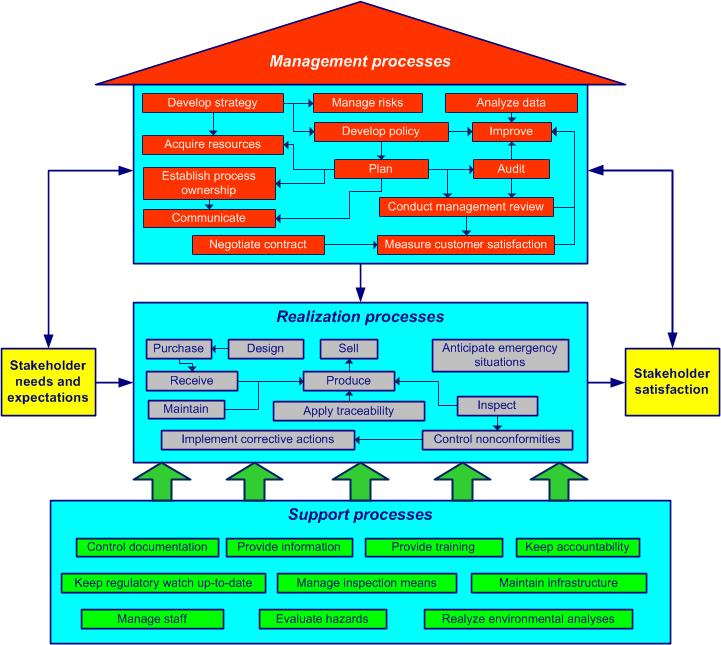
Figure 1-6. Process house
Mapping, among other things, allows you to:
- obtain a global vision of the company
- identify the beneficiaries (customers), flows and interactions
- define (simple) rules for communication between processes
To obtain a clearer picture, you can simplify by using a total of about 15 core processes. A core processactivities which transform inputs into outputs (see also ISO 9000, 3.4.1) can contain several sub-processes: for example, the processactivities which transform inputs into outputs (see also ISO 9000, 3.4.1) "develop the IMS" can involve:
- develop strategy
- manage risks
- develop policy
- plan the IMS
- deploy objectives
- acquire resources
- establish process ownership
- improve
1.3.3 Process approach
Simple solutions for now, perfection for later
The fourth principle of quality management is “Process approach” (see § 1.2.1). Some benefits:
- obtain a global vision of the company thanks to the mapping
- identify and manage responsibilities and resources
- achieve effective management of the company based on process indicators
- manage risks that could influence the objectives
Process approach: management by the processes to better satisfy customers, improve the effectiveness of all processes and increase global efficiency
When the process approachmanagement by the processes to better satisfy customers, improve the effectiveness of all processes and increase global efficiency (see also ISO 9004, Annexe B.5) is integrated during the development, implementation and continual improvementpermanent process allowing the improvement of the global performance of the organization (see also ISO 9000, 3.2.13 and ISO 14 001, 3.2) of a QSEquality, safety, environment management system, it allows one to achieve objectives that are related to customer satisfactiontop priority objective of every quality management system (see also ISO 9000, 3.1.4), as is shown in figure 1-7.
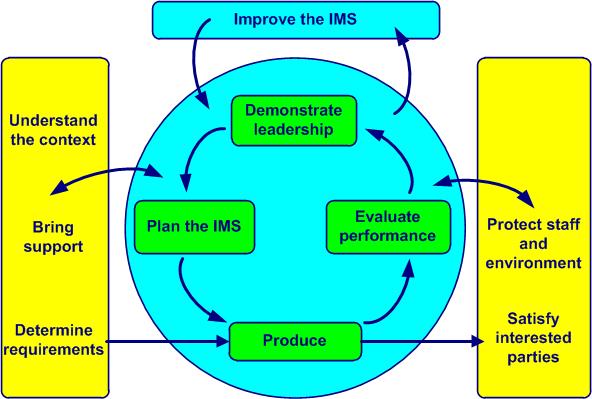
Figure 1-7. Model of an IMS based on the process approach and continual improvement
The process approachmanagement by the processes to better satisfy customers, improve the effectiveness of all processes and increase global efficiency (see also ISO 9004, Annexe B.5) (cf. annex 05):
- emphasizes the importance of:
- understanding and complying with customer requirements
- prevention so as to react to unwanted elements such as:
- incidents
- accidents
- nuisance
- waste
- rejections
- customer returns
- measuring process performance, effectiveness and efficiency
- permanently improving objectives based on pertinent measurements
- process added value
- relies on:
- methodical identification
- interactions
- the sequence and
- process management, which consists of:
- determining objectives and their indicators
- piloting related activities
- analyzing obtained results
- permanently undertaking improvements
- allows one to:
- better view inputs and outputs and their relationship
- clarify roles and responsibilities
- judiciously assign necessary resources
- break down barriers between departments
- decrease costs, delays and waste
- and ensures in the long run:
- control
- monitoring and
- continual improvement of processes
For a consulting, support or repair business identifying and defining processes and mapping may not be very useful. More important is to establish and describe for example:
- job descriptions
- staff competence
- the tools to use
- preferred methods for certain recurring cases
- crisis management ("You will not solve the problems by addressing the effects")
- blaming people (“Poor quality is the result of poor management" - Masaaki Imai)
- prioritizing investments (“Use your brain, not your money" - Taiichi Ohno)
.jpg) Minute of relaxation. Cf. game: Process
Minute of relaxation. Cf. game: Process

